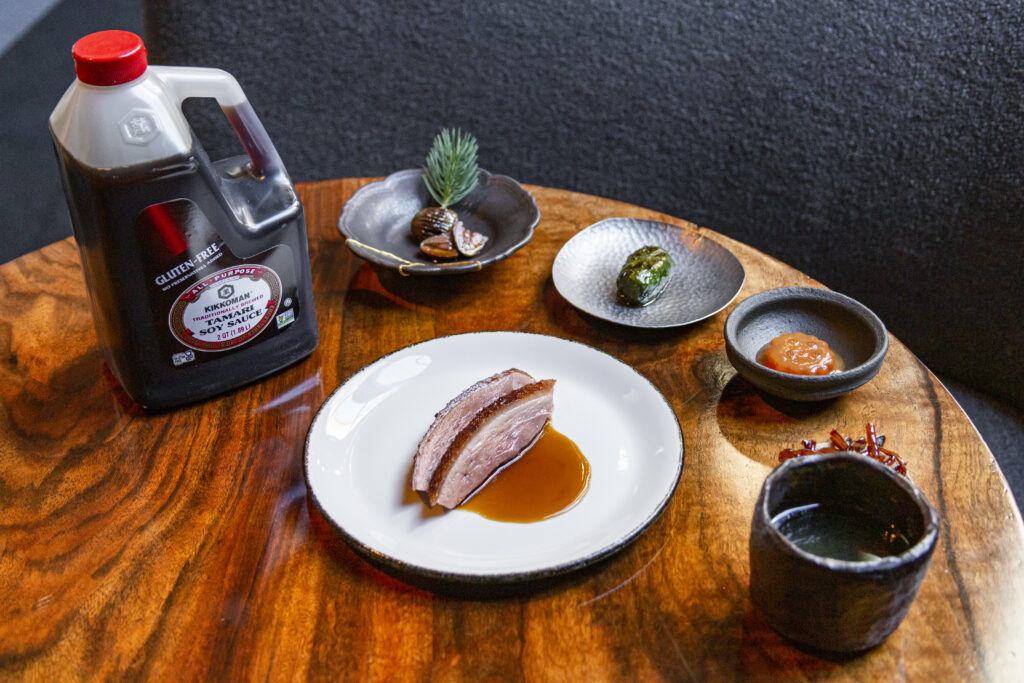For the Dry-Aged Duck Breast:
On a work surface, butcher ducks by removing duck legs and separating the neck and back, leaving the breast and rib cage intact. Reserve legs, neck, back, and bones. In a dry aging refrigerator set to 34°F and 75 percent humidity, hang duck cages for a minimum of 2 weeks, rotating every 2 days to ensure proper drying of skin.
For the Marinated Betel Leaves:
Using a mortar and pestle, pound garlic in a smooth paste. Add bean paste, fish sauce, sugar, salt, and miso. Pound again into a smooth paste. Transfer mixture to a large bowl and add 670 grams of water. Mix to combine. While wearing gloves, hold betel leaf and gently brush with the garlic-bean paste. Place seasoned betel leaf on a clean work surface. Repeat process with each leaf, layering leaves onto one another to form a stack. Place stack of marinated leaves into a non-reactive container and cover with plastic wrap. Press as much air out as possible and refrigerate. Marinate for 2 to 3 days before using.
For the Yuzu Koshō Yolk:
In a large bowl, combine mustard powder and 50 grams water. Stir until smooth. In a separate bowl, add 2 grams hydrated mustard powder, yuzu koshō, miso, tuna sauce, and egg yolks. Refrigerate for at least 3 days. Strain excess liquid and reserve egg yolks.
For the Duck Jus Base:
On a work surface, butcher each chicken into feet, wings, wing tips, wing arms, drumsticks, thighs, neck, back, and breasts. Slice each breast into 4 equal pieces. Transfer half of the chicken pieces to a sheet tray and let air-dry in refrigerator overnight. Repeat process for 2000 grams of the reserved duck bones. In a large bowl, add remaining chicken parts and season with salt. Let sit 10 minutes at room temperature. Transfer to a large stock pot and cover with 8 quarts water. Let simmer 4 hours. Strain stock into a non-reactive container, let cool, and reserve. The next day, heat oven to 325°F. In a rondeau over high flame, heat grapeseed oil. Reduce heat and add air-dried chicken pieces and garlic. Cook until chicken is browned on all sides. This can be done in batches to avoid overcrowding. Drain excess oil and add butter, continuing to cook until butter begins to foam. Season with pepper and cook additional 30 seconds. Add 8000 grams of the reserved chicken stock, tomatoes, shallots, mushrooms, peppers, and tamari. Bring to a simmer. Transfer chicken and braising liquid to a deep hotel pan and cover with aluminum foil. Braise in oven 6 to 8 hours, or until desired flavor is achieved. Strain liquid into a non-reactive container and set aside. Prepare and heat a charcoal grill. In a bowl, toss the air-dried duck bones with grapeseed oil. Grill bones over embers until a deep, brown color is achieved. In a large pot, combine bones with 4000 grams of the reserved chicken braising liquid. Simmer until flavors are balanced. Strain into a non-reactive container and reserve.
For the Lemon Oil:
Heat the water bath of an immersion circulator to 185°F. In a vacuum bag, combine lemon zest and oil; seal. Cook sous vide 2 hours. Transfer to a non-reactive container and cool overnight. The next day, strain through a chinois and reserve.
For the Duck Gizzards:
In a large stockpot over medium-high heat, combine salts and 8 quarts water. Bring to a simmer, then let cool. Rinse the gizzards in cold water and transfer to a bowl. Pour brine over gizzards and let soak overnight. The next day, heat the water bath of an immersion circulator to 185°F. Remove gizzards from brine and transfer to a vacuum bag with reserved duck fat, garlic, thyme, and pine; seal. Cook sous vide 6 hours. Let cool and reserve.
For the Duck Broth:
On a work surface, butcher each chicken into feet, wings, legs, thighs, and breasts. Transfer to a bowl and season with salt. In a large rondeau over medium-high heat, add chicken, 100 grams white soy and 8 quarts water. Simmer 2 hours, making sure to skim and reserve fat as necessary. Remove from heat and add remaining white soy and additional salt if needed. Strain through a cheesecloth- or coffee filter-lined chinois and let cool. Heat and prepare a charcoal grill. In a bowl, toss remaining reserved duck bones with oil and grill over medium embers until browned on all sides. Weigh broth and add 25 percent grilled duck bones by weight of broth. Steep 10 minutes, then strain again through a cheesecloth- or coffee filter-lined chinois. Transfer broth and reserved duck fat into separate non-reactive containers and reserve.
For the Duck Hearts:
In a resealable plastic bag, combine hearts and enough sweet soy to submerge. Refrigerate 5 hours.
For the Bellflowers:
In a large bowl, combine bellflower, bonito sauce, and 115 grams water. Transfer to a vacuum bag, seal, and let marinate 30 minutes. In a rondeau over medium-high heat, combine sesame oil and chiles and cook until fragrant. Add the marinated bellflower and stir to combine. Add sake and mirin and simmer 2 minutes. Add tamari, rice vinegar, sugar, and brown rice syrup. Reduce until the bellflower is glazed, but not so far reduced that the liquid takes on a syrup consistency. Add tuna sauce and stir to combine. Remove from heat and fold bellflower with glaze as it cools to ensure evening coating. Set aside.
For the Duck Sausage:
Chill, prepare, and assemble meat grinder with a large die. Butcher 5 reserved duck legs into 11⁄2-inch cubes. Transfer to a sheet tray and freeze until edges are frozen, but duck meat is still soft. Season with salt and sugar. Pass meat mixture through the grinder. Transfer to a blast chiller and chill until edges are frozen. Meanwhile, prepare and assemble meat grinder with a small die. Pass meat through the grinder twice. Transfer to a large bowl, and by hand, mix in garlic, shallots, chicken stock, and chaat masala. Do not overwork the farce, or the meat will become tough and springy. Portion farce into 30 gram fingers. Set aside.
For the Savory Brown Butter:
In a saucepot over medium-high heat, combine buttermilk and butter. Bring to a simmer and cook, stirring occasionally, until butter is browned. Remove from heat and add the savory leaves. Steep 10 minutes. Strain through a coffee filter-lined chinois and let cool.
For the Spiced Brown Butter:
In a saucepan over medium-high flame, heat butter until browned. Remove from heat and add fennel, coriander, and orange zest. Strain through a coffee filter-lined chinois and let cool.
For the Salted Cherry Leaf Duck Jus:
In a saucepot over medium-high flame, heat clarified butter. Add shallots and garlic. Sweat until soft and translucent. Add black pepper and toast until fragrant. Deglaze with vinegar. Add 1300 grams Duck Jus Base and bring to a simmer. Cook 5 to 10 minutes. Add salted cherry leaves and steep until flavors are fully extracted. Strain into a mixing bowl. Weigh. Add .2 percent xanthum gum by weight of jus and whisk until fully hydrated. Strain through a fine sieve and let cool.
For the Pickled Pluots:
In a stockpot over medium-high heat, combine vinegar, salt, sugar, and 400 grams water. Bring to a simmer, stirring constantly. Pass through a chinois into a mixing bowl set over an ice bath and let cool. In a vacuum bag, compress pluots and 500 grams reserved pickling liquid.
For the Soy Glaze:
In a large stockpot, combine sugar, tamari, white soy, sake and 7500 grams hot water. Bring to a simmer, whisking regularly to dissolve sugar. Continue until glaze is reduced by at least 70 percent. Cool immediately in a blast chiller. Transfer to a non-reactive container and set aside.
To Assemble and Serve:
Heat combination oven to 375°F with fan on speed 4. Prepare a cold smoker with almond wood. Using a pairing knife, remove wishbone from 1 Dry-Aged Duck Breast. Cold smoke Dry-Aged Duck Breast for 10 minutes. Transfer to sheet tray and rub with honey, five-spice, and sea salt. Roast 16 minutes, rotating halfway through. Remove from oven and let rest. Once cooled, remove Dry-Aged Duck Breast from the rib cage. Cut into 4 even slices. Brush with Spiced Brown Butter and season with salt. Set aside. Heat and prepare a charcoal oven. Remove Duck Hearts from marinade and skewer. Grill skewers 2 to 3 minutes over medium embers, or until desired doneness. Keep grill hot. Let Duck Hearts rest 1 minute then slice in half and brush with Soy Glaze. Skewer Duck Gizzards and brush with sweet soy. Grill skewers over medium embers until desired doneness. Keep grill hot. Dress with Yuzu Koshō Yolk and brush with additional sweet soy. Set aside. Grill Duck Sausage over medium embers until lightly browned. Remove from heat and let cool. Keep grill hot. Meanwhile, in a small saucepan, warm Duck Broth. Wrap grilled Duck Sausage in Soy-Marinated Betal and sear again over hot embers. Let cool. Remove Duck Hearts and Duck Gizzards from skewers. In a mixing bowl, dress 1 Duck Heart and 1 Duck Gizzard with Savory Brown Butter, lemon juice, and sea salt. Skewer Duck Gizzard with a small pine branch. Set aside. Slice 5 Pickled Pluots into quarters. Brush with 3 grams Lemon Oil and transfer to a side serving bowl. Top with fennel pollen and sea salt. Place a small handful of Bellflowers in the middle of a small serving plate. On a large serving plate, place two slices of Dry-Aged Duck Breast, offset left and center. Add a spoonful of Salted Cherry Leaf Duck Jus to the middle of the plate. On a medium-sized serving plate, place Duck Sausage. On a small side serving plate, place skewered Duck Gizzard and Duck Heart side by side. Finally, pour the warmed Duck Broth into a small serving bowl. Serve all plates and bowls, a total of 6 serving pieces, at once.
Created by Chef Richard Lee of Saison, Adapted by StarChefs

